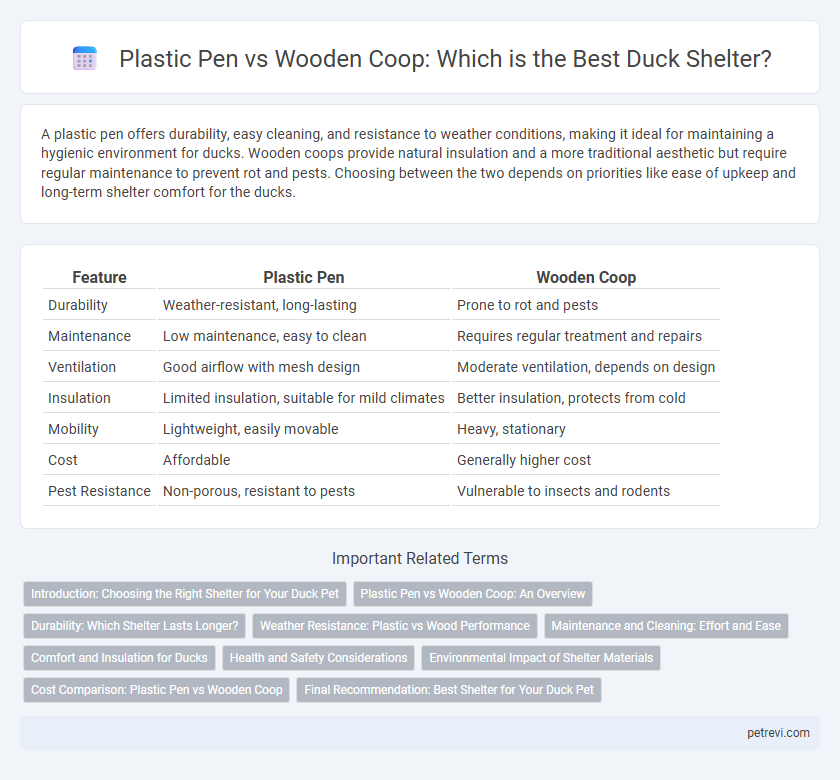A plastic pen offers durability, easy cleaning, and resistance to weather conditions, making it ideal for maintaining a hygienic environment for ducks. Wooden coops provide natural insulation and a more traditional aesthetic but require regular maintenance to prevent rot and pests. Choosing between the two depends on priorities like ease of upkeep and long-term shelter comfort for the ducks.
Table of Comparison
| Feature | Plastic Pen | Wooden Coop |
|---|---|---|
| Durability | Weather-resistant, long-lasting | Prone to rot and pests |
| Maintenance | Low maintenance, easy to clean | Requires regular treatment and repairs |
| Ventilation | Good airflow with mesh design | Moderate ventilation, depends on design |
| Insulation | Limited insulation, suitable for mild climates | Better insulation, protects from cold |
| Mobility | Lightweight, easily movable | Heavy, stationary |
| Cost | Affordable | Generally higher cost |
| Pest Resistance | Non-porous, resistant to pests | Vulnerable to insects and rodents |
Introduction: Choosing the Right Shelter for Your Duck Pet
Selecting the ideal shelter for your pet duck involves evaluating the benefits of plastic pens versus wooden coops, considering factors like durability, maintenance, and protection from predators. Plastic pens offer lightweight, water-resistant features that simplify cleaning and resist rot, while wooden coops provide robust insulation and natural ventilation essential for duck comfort. Proper shelter choice enhances the health, safety, and overall well-being of your duck, ensuring a secure and comfortable living environment.
Plastic Pen vs Wooden Coop: An Overview
Plastic pens offer lightweight, weather-resistant, and easy-to-clean options for duck shelters, making maintenance straightforward. Wooden coops provide better insulation and natural airflow but require regular treatment to prevent rot and pests. Choosing between plastic and wood hinges on balancing durability, temperature regulation, and upkeep demands for optimal duck comfort.
Durability: Which Shelter Lasts Longer?
Wooden coops generally offer greater durability for duck shelters due to their natural resistance to wear and environmental factors compared to plastic pens, which can become brittle and crack over time when exposed to UV rays. High-quality treated wood can withstand moisture and temperature fluctuations, prolonging the life of the shelter significantly. While plastic pens may be lightweight and resistant to rust, their durability often falls short in long-term outdoor use.
Weather Resistance: Plastic vs Wood Performance
Plastic pens offer superior weather resistance for duck shelters, effectively withstanding rain, humidity, and temperature fluctuations without deteriorating. Wooden coops, although sturdy, are prone to rot, warping, and insect damage when exposed to prolonged moisture and harsh weather conditions. Choosing plastic enhances longevity and reduces maintenance, ensuring a more durable and weatherproof environment for ducks.
Maintenance and Cleaning: Effort and Ease
Wooden coops require regular sealing and occasional repairs to prevent rot and pest damage, increasing maintenance efforts for duck shelters. Plastic pens offer easy-to-clean surfaces resistant to moisture and mold, significantly reducing labor and time compared to wooden structures. Ducks housed in plastic pens benefit from improved hygiene due to less bacterial buildup and simpler waste management.
Comfort and Insulation for Ducks
Wooden coops provide superior insulation for duck shelters, maintaining stable temperatures that enhance duck comfort during both hot and cold weather. The natural fibers of wood offer better breathability and moisture regulation compared to plastic pens, reducing the risk of dampness and respiratory issues. Ducks housed in wooden coops experience a more comfortable environment, promoting healthier growth and wellbeing.
Health and Safety Considerations
Plastic pens for duck shelters offer easy cleaning and resistance to moisture, reducing the risk of bacterial buildup and promoting better hygiene. Wooden coops provide natural insulation and breathability, which helps regulate temperature and reduce respiratory issues in ducks. However, untreated wood can harbor parasites and mold, necessitating regular maintenance to ensure a safe environment.
Environmental Impact of Shelter Materials
Wooden coops provide a more sustainable and biodegradable option for duck shelters compared to plastic pens, which contribute to long-term environmental pollution due to their non-biodegradable nature. The production of plastic requires significant fossil fuel resources and releases harmful greenhouse gases, whereas sustainably sourced wood has a lower carbon footprint and can be replenished. Using wooden shelters supports eco-friendly practices by minimizing plastic waste and promoting renewable materials in duck habitat construction.
Cost Comparison: Plastic Pen vs Wooden Coop
A plastic pen typically costs 20-30% less upfront than a wooden coop, making it a budget-friendly option for duck shelters. Plastic pens require minimal maintenance and resist weather damage, reducing long-term expenses, while wooden coops often involve higher repair costs due to rot and pest issues. Evaluating durability alongside initial price is crucial for an accurate cost comparison between plastic pens and wooden coops.
Final Recommendation: Best Shelter for Your Duck Pet
A wooden coop provides superior insulation and natural breathability, creating a healthier environment for pet ducks compared to plastic pens which can trap heat and condensation. Durable hardwoods resist wear and offer better protection from predators, making wooden shelters a safer, longer-lasting investment. For optimal comfort, safety, and longevity, a well-constructed wooden coop is the best shelter choice for your duck pet.
Plastic Pen vs Wooden Coop for Duck shelter Infographic

 petrevi.com
petrevi.com